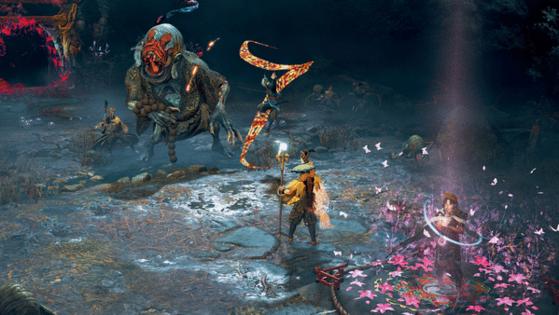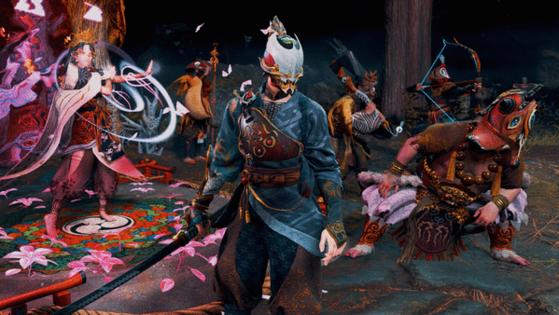
Thirty
years ago, a game like “Kunitsu-Gami: Path of the Goddess” may never
have made it to American shores. Publishers would have judged it too
foreign, with characters influenced by Japanese folklore and fighting
moves inspired by an ancient form of dance called the kagura.
Capcom’s latest title, an action-strategy game, would have been hard to explain to U.S. audiences in the past, but the pop culture landscape has changed, with anime becoming more mainstream and gamers more interested in Japanese culture. In that environment, a project such as “Kunitsu-Gami” can carve a niche for itself based not just on the gameplay but also the subject matter as well.
It’s a fascinating title that mixes the strategy of tower defense games with the visceral combat of an action title such as “Devil May Cry.” Thrown in the mix is a dabble of “Pikmin” for good measure. It’s an amalgam of genres that works but it also has some of the console drawbacks.
Capcom’s latest title, an action-strategy game, would have been hard to explain to U.S. audiences in the past, but the pop culture landscape has changed, with anime becoming more mainstream and gamers more interested in Japanese culture. In that environment, a project such as “Kunitsu-Gami” can carve a niche for itself based not just on the gameplay but also the subject matter as well.
It’s a fascinating title that mixes the strategy of tower defense games with the visceral combat of an action title such as “Devil May Cry.” Thrown in the mix is a dabble of “Pikmin” for good measure. It’s an amalgam of genres that works but it also has some of the console drawbacks.

THE STORY SO FAR
“Kunitsu-Gami” follows the Maiden Yoshiro and her Guardian Soh who are traveling around Mount Kafuku when a defiling essence takes over the land. Villagers are cocooned up and monsters called Seethe attack whoever is out at night. It’s up to the two to purify the contagion spreading on the mountain. That will take them through 27 chapters, where the two have to rescue villagers, rebuild their towns and fight bosses inspired by “yokai,” a Japanese term for creepy-looking spiritual beings.
The campaign is divided into two types of levels. The first drops Yoshiro and Soh in the village at daytime. Players must quickly purify defilement and rescue cocooned villagers. They’ll have a carpenter who can repair contraptions such as barriers or drums that dispel curses. Soh can assign villagers new jobs based on the classes they unlock. They can transform them to Archers for ranged attacks against flying enemies or sumo wrestlers to soak up damage as tanks.
Assigning roles to villagers is part of the depth as players have to figure out how to defend the maiden before nightfall. Once that happens, the Torii gates turn into portals that allow the Seethe to inundate the battlefield. Soh and the villagers will have to battle through the night. Defeating adversaries gives players crystals, which is the resource that allows Soh to transform villagers to Spearman that will fight for the cause or a Shaman who will heal the defenders.

HOW TO WIN
This part of “Kunitsu-Gami” is comparable to a tower defense game, but Soh is a hero character who can turn the tide of battle and make up for any shortcomings on defense. The Guardian is also in charge of using crystals to carve a path for Yoshiro so she can purify the corrupted Torii gates and clear a level.
Although it’s a simple concept, the developers do a smart job of mixing up the level design so that players will have to adapt to different scenarios. Some levels call for players to keep lanterns lit during battle while other confrontations take place on the water. The team experiments with unusual concepts and it shows how much potential this take on the tower defense has.
The second level-type are boss battles. Most of the time, the villagers saved in the previous level are available for these encounters. Players have to figure out the type of battalion to build to take on the monster awaiting them. Some bosses will be weak to ranged attacks while others require tough fighters that can take a powerful blow and still keep attacking.
CONSOLE DRAWBACKS
In “Kunitsu-Gami,” Soh is essentially immortal. When the guardian loses all their health, they turn into a spirit and have to wait to return to battle but they can still heal minions using rations. Players will only lose when Yoshiro loses all her health. In boss battles, players have to balance doing an all out attack against the major adversary or rushing back to protect the maiden. Players have simple commands for assaults and defense, and that makes the game feel like “Pikmin” at times.
The big issue with this setup is that in tougher confrontations players will need to quickly space out their squad to avoid a major attack or carefully maneuver their soldiers in better positions. When this happens, players have to pause the fight and move every unit individually, which slows the game and feels clunky on consoles. It’s a problem that has plagued real-time strategy elements in console games.
When it comes to an unusual title like this, the developers have to teach players the core concepts before ramping up the difficulty, and the team behind “Kunitsu-Gami” does that well. Even when it gets difficult, the design is flexible enough that players can switch around the upgrades on their soldiers to emphasize different strategies with stronger minion types. In addition to this flexible progression, players will also pick up new abilities and power-boosting trinkets that they can equip.
It’s another layer of depth to for a genre-bending project that mostly succeeds at mixing disparate elements into a cohesive and fascinating world of Japanese folklore.
‘Kunitsu-Gami: The Path of the Goddess’
3 stars out of 4
Platform: PlayStation 5, PlayStation 4, Xbox Series X and Series S, Xbox One, PC
Rating: Teen
©2024 MediaNews Group, Inc. Visit at mercurynews.com. Distributed by Tribune Content Agency, LLC.




